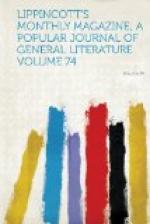it is all about. This law of habitual action
applies not only to the lower nerve-centres in their
healthy condition, but with equal force in disease.
It is notorious that one of the great difficulties
in the cure of epilepsy is the habit which is acquired
by the nerve-centres of having at intervals attacks
of convulsive discharge of nerve-force. Some
years since I saw in consultation a case which well
illustrates this point. A boy was struck in the
head with a brick, and dropped unconscious. On
coming to be was seized with an epileptic convulsion.
These convulsions continually recurred for many months
before I saw him. He never went two hours without
them, and had usually from thirty to forty a day—some,
it is true, very slight, but others very severe.
Medicines had no influence over him, and with the
idea that there might be a point of irritation in
the wound itself causing the epilepsy, the scar was
taken out. The result was that the seizures were
the same day reduced very much in frequency, and in
a short time became amenable to treatment, so that
finally complete recovery occurred. He had, however,
probably fifty convulsions in all after the removal
of the scar before this result was achieved.
Undoubtedly, in this case the point of irritation was
removed by the operation. The cause of the convulsions
having been taken away, they should have stopped at
once. But here the law of habitual action asserted
itself, and it was necessary to overcome the remembrance
of the disease by the nerve-centres. It is plain
that the higher nerve-centre remembers the idea or
fact because it is impressed by ideas and facts, precisely
as the lower spinal nerve-centres in the frog remember
irritations and movements which have impressed them.
The faculty of memory resides in all nerve-centres:
the nature of that which is remembered depends upon
the function of the individual centre. A nerve-cell
which thinks remembers thought—a nerve-cell
which causes motion remembers motion.
The so-called cases of double consciousness are perfectly
simple in their explanation when the true nature of
memory is borne in mind. In these cases the subject
seems to lead a double life. The attacks usually
come on suddenly. In the first attack all memory
of the past is lost. The person is as an untaught
child, and is forced to begin re-education. In
some of these cases this second education has gone
on for weeks, and advanced perhaps beyond the stage
of reading, when suddenly the patient passes back
to his original condition, losing now all memory of
events which had occurred and all the knowledge acquired
in what may be called his second state, but regaining
all that he had originally possessed. Weeks or
months afterward the second state reoccurs, the individual
now forgetting all memory of the first or natural
condition. It is usually found that events happening
and knowledge acquired during the first attack of
what we have called the second state are remembered




